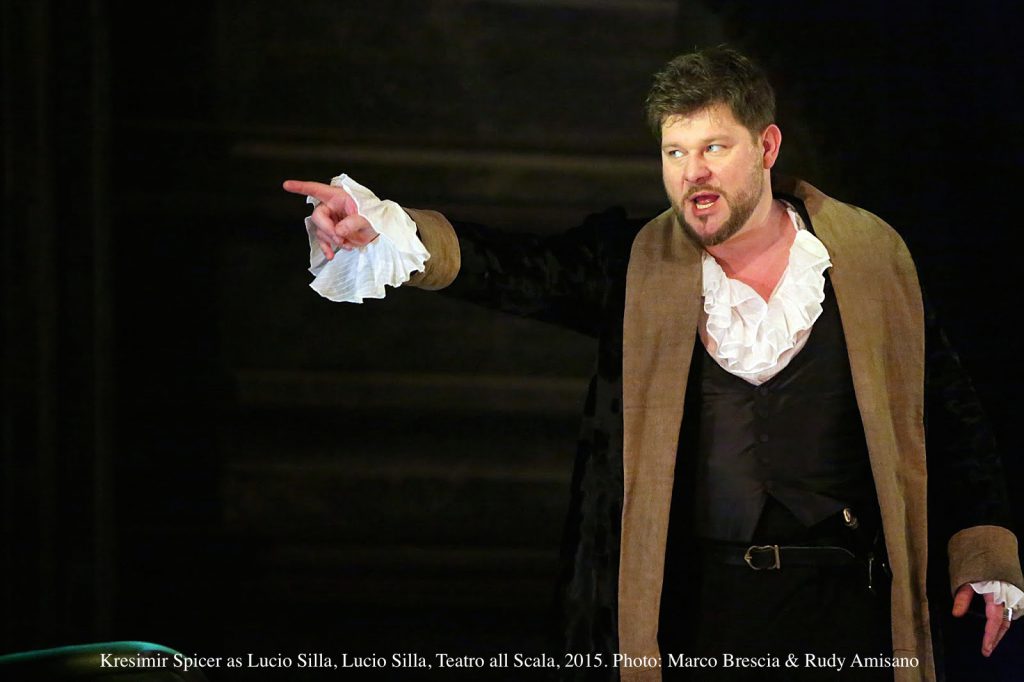Leopold Mozart had high hopes. His son, 16-year old Wolfgang Amadeus, had been invited back to Milan by resident Hapsburg governor Count Karl Joseph Fermion to compose a new opera for Carnivale. It would be the pair’s third visit to Italy. Leopold felt confident that this time the commission would yield a lucrative appointment for his celebrity offspring at the cultivated Lombardy court. The Mozarts had no sooner arrived after a long, miserable journey from Austria in mid-November 1772 when things began to go wrong. Despite rewrites by veteran librettist Pietro Metastasio, local poet/playwright Giovanni de Gamerra’s classic dramma per musica, a flashy portrait of Roman dictator Lucius Sulla, was still less than polished. Singers appeared on the scene late in rehearsal and, to make matters worse, the tenor lead was forced to withdraw at short notice due to illness. Wolfgang worked feverishly to adapt his score, drastically scaling down the central role, shifting focus from villain to protagonists, all in under three weeks. The première teetered on the edge of disaster. The curtain rose three hours late. Principals squabbled. The addition of extraneous scenic ballets nudged the performance into the early hours of the next morning. Milan went to bed exhausted. And increasingly captivated. By the time Lucio Silla closed several months later, Leopold had turned a tidy profit at the box office. He and Wolfgang returned to Salzburg. Wolfgang still had no position. Neither would ever see Italy again.
Over 240 years after its first appearance, Milan’s glorious Teatro alla Scala returns Lucio Silla to the city where it all began, exuberantly staged with trademark grace and sleek physicality by Toronto Opera Atelier director Marshall Pynkoski and choreographer Jeanette Lajeunesse Zingg. The production, originated at the Salzburg Festival in Summer 2013 by acclaimed early music conductor Marc Minkowski, reunites the deft collaborative trio in an evening of lavish Baroque musical theatre, extravagantly dramatic, fervently played and sung.
Like its earlier Milanese companion pieces, Mitridate, re di Ponto and Ascania in Alba, penned by Mozart on previous trips to the northern Italian capital, Lucio Silla is a product not only of place, but more importantly of time. Sensational and melodramatic, preposterously irrational, the riotous saga of love, lust and corruption is stupendously overwrought in best eighteenth century style. Mozart’s audience accepted, even demanded, hyperbole as an operatic fact of life. From narrative excessiveness flowed torrents of lush orchestral melodies and show-stopping arie da capo. Lucio Silla’s storyline is positively awash with Baroque musical possibility.
The worthy senator Cecilio, banished by the tyrant, Lucio Silla, secretly returns to Rome to seek his cherished Giunia. Encountering his friend and ally, Lucio Cinna, Cecilio learns that Silla has spread rumours of Cecilio’s death in an attempt to claim Giunia for his own. Silla, counselled by his sister, Celia, attempts to win Giunia’s affections, threatening her when she shuns his advances. Never will she surrender to the ruthless despot who slew her beloved father. Later, at the fallen patrician’s tomb, Giunia and Cecilio are joyfully reunited.
Secluded in his private apartments, Silla resolves to marry Giunia, motivated as much by politics as love. It will be a double ceremony. Celia shall wed Cinna, long the object of her desire. Elsewhere, Cinna and Cecilio confer. Cecilio proclaims his intention to take Silla’s life. Fearing for Giunia’s safety should the attack fail, Cinna, who also wishes the loathed dictator dead, urges Giunia to marry Silla, then murder him in their wedding bed. Horrified, Giunia refuses. Cinna resolves to kill Silla himself. Summoning Giunia to his palace, Silla is wracked by opposing emotions. Though he idolizes the proud young woman, her implacable resistance is insulting. Redoubling his threats, Silla vows to execute any who would oppose him. Giunia flees. Desperate and terrified, she begs Cecilio to save himself before Silla strikes. Cecilio pledges never to abandon her, even in death. His shadow will forever watch over her. Striding into the heart of the Forum, Silla demands the assembled Senators consent to his proposed marriage to Giunia. Cecilio and Cina burst onto the scene. Cecilio draws his sword and is promptly arrested. Cinna feigns innocence. He raised his blade to protect the emperor, not to strike him down. Cecilio and Giunia swear their eternal love as Cecilio is led to prison. Silla cannot help but be moved.
Plagued by his act of cowardice, Cinna agrees to marry Celia if she will urge Silla to follow a more temperate, humane course of action. Giunia and Cecilio bid each other a final tender farewell but when Cecilio is brought before Silla for execution, the once vengeful autocrat has a sudden, stunning change of heart. The strength of Giunia and Cecilio’s devotion has shown him the error of his ways. Cecilio is pardoned. He and Giunia shall wed as they always wished. Cinna, who has since confessed his role in the assassination plot, is forgiven. Opponents of Silla shall no longer be banished. Henceforth the emperor shall be governed by the will of the people. Love and freedom reign. All Rome rejoices.
Credibility and reason take a considerable beating in Lucio Silla but Enlightenment ideals, however contrived, are ultimately upheld as befits a proper opera seria. The awkward period romance has never figured prominently in the Mozartian catalogue. Idomoneo is an infinitely richer, more nuanced exploration of humanity, certainly. La Clemenza di Tito, a work Lucio Silla more than superficially resembles, is a much more meaningful treatise on morality and power. Nevertheless, for all its staginess, Lucio Silla has undeniable appeal. Characters, obsessed and profoundly conflicted, are revealed with a depth of psychological insight instantly recognizable in the 21st century.
As director, Marshall Pynkoski is respectful but far from slavish in defining Lucio Silla’s historical frame of reference. Formal Baroque gesture and movement abound, stylized and striking. But there is a muscular athleticism at play in Pynkoski’s juggling of singer actors here as well. The vast La Scala stage is his chessboard. Characters leap and race across it. A tense, taut quality of simmering tension persists even in moments of stillness. Silla’s menacing, violent world, strikingly brought into focus by designer Antoine Fontaine’s hulking neoclassical columns and eye-catching, multi-layered scrims, seems forever about to shatter.
Musically, this vibrant, animated Lucio Silla is every bit as dynamic as its theatrical realization. Mozart’s visits to Italy as an adolescent, motivated in part by his father Leopold’s desire to enrol his son in the equivalent of a peninsular finishing school, had a profound impact on Wolfgang’s style. Time spent composing in Milan brought with it new experiments in melody and harmony, unique phrasing, bold transitions. Nothing similar had ever appeared in Italian music, or indeed in Mozart himself before. Maestro Minkowski brilliantly captures all the wonder and excitement that the young teenage prodigy must have felt. L’Orchestra del Teatro alla Scala plays with meticulous coordination and superb period flavour.
As the dictator Lucio Silla, tenor Kresimir Spicer summons a character of compelling villainy, brutal, vengeful, a prisoner of his ambition. Spicer’s voice, simultaneously commanding and honeyed, drips with delicious malevolence. Possessed of seemingly inexhaustible vitality, this fine Croatian artist is all-conquering despite Silla’s limited stage time. Footnoting Act II with a spectacular extended aside, Minkowski transplants an epic, 14-minute concertante aria, Se al generoso audire (“If the generous boldness”), plucked from a later Lucio Silla by Mozart mentor Johann Christian Bach, into the tumultuous proceedings. Perched on the rim of the orchestra pit a mere arms length from the audience, Spicer brings a spirited intensity to the emperor’s moral epiphany, clearly revelling in the intimate setting.
Appearing as Giunia, soprano Lenneke Ruiten performs with great poise and engagement. Her treatment of her anguished character’s sorrowful lament, Fra pensier più funesti di morte (“Hedged about by gloomy thoughts of death”) is quite simply exquisite, delivered with luscious legato and flawless phrasing. Strong-willed yet tender, precariously balanced on the edge of her emotions, Ruiten portrays an affecting Giunia, fresh, clear-toned and strong.
Singing one of Lucio Silla’s two taxing trouser roles, Marianne Crebassa delivers a heroic Cecilio, valiant, dashing and romantic. A period specialist, the accomplished French mezzo, with her bright, athletic top and remarkably resonant lower reach, admirably embodies the character. Vocally quick and fearless, physically agile, this is a Cecilio to be reckoned with either in combat or in love. Crebassa’s contribution to Mozart’s gorgeous Cecilio-Giunia reunion duet, D’Elisio in sen m’attendi (“In Elysium await me”) is utterly delightful.
Second mezzo Inga Kalna is Cinna, darker hued but no less limber than Crebassa, delivering a skilful, keen-edged performance, dramatically sharp, vocally expansive. Giulia Semenzato is Celia, an irresistible, scene-stealing scamp, all superficial bubbliness and innocence, a whiff of malice perfuming her passage through the evening’s events.
Il Coro del Teatro alla Scala partners the uniformly gifted cast, lending rich, robust colour, singing both from the pit and on stage. Il Corpo di Ballo del Teatro alla Scala brings Jeanette Zingg’s zestful choreography to life, a swirl of Baroque velvet and satin gowns, the men high-flying acrobats in matching modern dance garb.
Like the vast majority of Mozart’s early operas, Lucio Silla quickly fell from favour following the composer’s untimely death in 1791. Incredibly, it would not be produced again until 1929 in Prague. The work is unquestionably problematic. With their sumptuous, elegant La Scala production, Minkowski, Pynkoski and Lajeunesse Zingg have done impressive work rehabilitating the piece, hopefully ensuring it will stay firmly rooted in the repertoire. This Lucio Silla glows.


